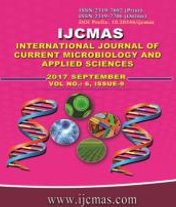


 National Academy of Agricultural Sciences (NAAS)
National Academy of Agricultural Sciences (NAAS)

|
PRINT ISSN : 2319-7692
Online ISSN : 2319-7706 Issues : 12 per year Publisher : Excellent Publishers Email : editorijcmas@gmail.com / submit@ijcmas.com Editor-in-chief: Dr.M.Prakash Index Copernicus ICV 2018: 95.39 NAAS RATING 2020: 5.38 |
Neonatal sepsis is one of the most common causes of mortality and morbidity, particularly the developing countries. Accurate and timely diagnosis of neonatal sepsis remains a major challenge to the pediatricians and neonatologists. The objective of this study was to determine the causative bacteria and pattern of susceptibility to antibiotics in NICU of a tertiary care center, which in turn may help in implementation of empirical therapy. This prospective study was carried out in the department of microbiology, Govt. medical college Raigarh (c.g.) during Jun 2016- Jun 2017. A total of 255 cases of blood cultures are donein our microbiology department. Out of which, 120 cases were positive (Bac Talert) for culture. A total of 120 cultures were found to be positive out of 255 cases (47.0%). The most common organism isolated was Staphylococcus aureus (40.2%), followed by Klebsiella pneumonia (37 %) and Escherichia coli (14%) other organisms were much less in number. which included pathogenic Streptococci, coagulase negative Staphylococcus (CoNS), Pseudomonas, Acinetobacter and Enterobacter species. Candida albicans also isolated. The gram positive organisms except Streptococci displayed a high degree of resistance to most penicillins and ciprofloxacin but were sensitive to vancomycin, amikacin and linezolid. There was a high incidence of resistance noted with ampicillin, gentamicin and ciprofloxacin, amongst most gram negative organisms’ where in ceforuxime, amikacin and meropenem, imipenem, netilmycin were effective in most cases. There is an increasing trend of antibiotic resistance to the commonly used first line drugs. Continuous surveillance for antibiotic susceptibility is needed to ensure proper empirical therapy.
 |
 |
 |
 |
 |